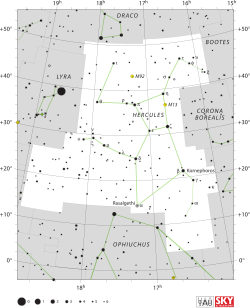Hercules (astronomy)
| Constellation | |

|
|
| Abbreviation |
Her genitive = Herculis |
|---|---|
| Pronunciation |
/ˈhɜːrkjᵿliːz/, genitive /ˈhɜːrkjᵿlᵻs/ |
| Symbolism | Heracles |
| Right ascension | 17 |
| Declination | +30 |
| Family | Hercules |
| Quadrant | NQ3 |
| Area | 1225 sq. deg. (5th) |
| Main stars | 14, 22 |
|
Bayer/Flamsteed stars |
106 |
| Stars with planets | 15 |
| Stars brighter than 3.00m | 2 |
| Stars within 10.00 pc (32.62 ly) | 9 |
| Brightest star | β Her (Kornephoros) (2.78m) |
| Nearest star |
Gliese 661 (20.62 ly, 6.32 pc) |
| Messier objects | 2 |
| Meteor showers | Tau Herculids |
| Bordering constellations |
Draco Boötes Corona Borealis Serpens Caput Ophiuchus Aquila Sagitta Vulpecula Lyra |
|
Visible at latitudes between +90° and −50°. Best visible at 21:00 (9 p.m.) during the month of July. |
|
Her
Hercules is a constellation named after Hercules, the Greek mythological hero adapted from the Greek hero Heracles. Hercules was one of the 48 constellations listed by the 2nd century astronomer Ptolemy, and it remains one of the 88 modern constellations today. It is the fifth largest of the modern constellations.
Hercules is bordered by Draco to the north; Boötes, Corona Borealis, and Serpens Caput to the east; Ophiuchus to the south; Aquila to the southwest; and Sagitta, Vulpecula, and Lyra to the west. Covering 1225.1 square degrees and 2.970% of the night sky, it ranks 5th among the 88 constellations in size. The three-letter abbreviation for the constellation, as adopted by the International Astronomical Union in 1922, is 'Her'. The official constellation boundaries, as set by Eugène Delporte in 1930, are defined by a polygon of 32 segments (illustrated in infobox). In the equatorial coordinate system, epoch 2000, the right ascension coordinates of these borders lie between 16h 00m 26.64s and 18h 57m 49.50s, while the declination coordinates are between +3.67° and +51.32°. In mid-northern latitudes, Hercules is best observed from mid-Spring until the early part of the Fall season, culminating at midnight on June 13.
...
Wikipedia
